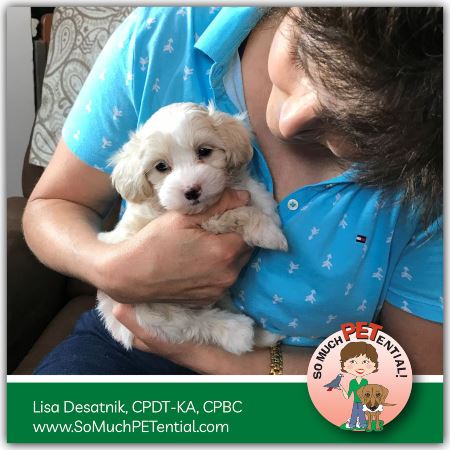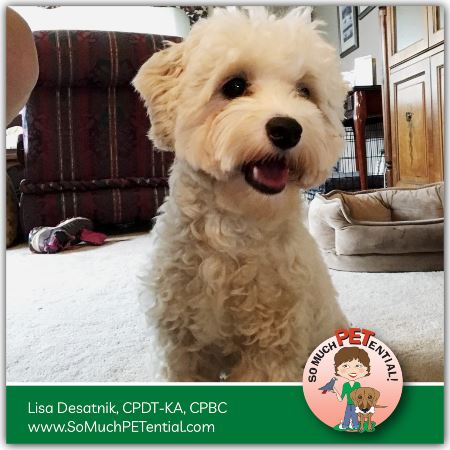My dear Dawson has changed my life in so many ways, given me a greater understanding of behavior, and helped me to have even deeper empathy for others who have a dog with anxiety issues, fear, or other behavioral problems. He has taught me important lessons in love, acceptance of imperfections, and being open to new paths in life.
He was about six weeks old when I met him for the first time – a tiny bundle of off-white fur, weighing just around two pounds. I remember him relaxing as I held him against my chest, then chasing the toy I was moving around him.
 The ride home was filled with a constant flow of my imagined future with him. I envisioned bringing him to a variety of places where children, adults, and seniors would smile more in his presence. Their day would be brightened because of my little teddy bear who wiggled, played, and snuggled his way into their heart. I had hoped that maybe he could even be a therapy dog so that we could visit people most in need of his clownish love. I pictured documenting lessons learned from and taught to him in videos and articles. He would give me a wonderful opportunity to help others through my own first hand mistakes and successes. AND, I thought too about how much fuller my life would be with his being a part of it.
The ride home was filled with a constant flow of my imagined future with him. I envisioned bringing him to a variety of places where children, adults, and seniors would smile more in his presence. Their day would be brightened because of my little teddy bear who wiggled, played, and snuggled his way into their heart. I had hoped that maybe he could even be a therapy dog so that we could visit people most in need of his clownish love. I pictured documenting lessons learned from and taught to him in videos and articles. He would give me a wonderful opportunity to help others through my own first hand mistakes and successes. AND, I thought too about how much fuller my life would be with his being a part of it.
When I began telling others my big news, the most common comment I received back was something like this, “You will have the most well-trained dog there is.”
Yes, there were a lot of high hopes for my boy and I couldn’t wait to begin our journey.
The Homecoming
Dawson was 10.5 weeks old when he came home. I planned on taking that week off from work as I knew I wanted to be able to spend plenty of time getting him acclimated to and feeling good about his new environment, his new companion, life without the only family he had known up until that point.
I had a lot of early training goals. Among the things I wanted to teach him were that humans who look and act differently can make good things happen; that paying attention to humans (and particularly me) is worth the effort; that a crate is a calming place to rest; that when he hears a clicker or other verbal marker like YES, that it means good things will follow; that settling and enjoying his own company is good; that the choices I want him to make for chewing and exercise are the choices he will mostly like make because I’ve put into place management and a selection of acceptable activities; that his world is safe and fun; that loud noises, cars, and unfamiliar things are ok; that car rides take him to safe and enjoyable places; that touching and grooming him are ok (and can even feel good). I also wanted him to have positive experiences seeing and interacting with other dogs, and teach him that even around other dogs, that he should sit, pay attention and walk with me.
He has also learned to go into his crate or to his bed or mat, sit, drop, hand target, turn, peak-a-boo (for standing in between my legs), leg weave, wait, get it, paws up (for paws up on a raised surface), chin (for placing his chin in my hand palm), give me his paw, kennel up (to get into his car crate), here (his recall word) and he is learning to crawl. On leash, he knows ‘let’s go’, turn right, turn left, this way, go sniff, say hi, wait, to walk by my side.
Still, I often tell others that he has taught me as much as I have taught him; and for those reasons, he has earned the fun title of ‘director of joyful learning’ at So Much PETential.
I have shared publicly dozens of photos, endearing stories, and videos of my life with Dawson. He has accompanied me on numerous television interviews. Together we have been invited to businesses and have frequented area pet friendly stores, outdoor spaces, and friends’ homes.
However, there is another side to my life with my little buddy that I have only shared with people in my inner circle, some clients, and my veterinary behaviorist (Dr. Lisa White).
I just had not been ready to talk about it openly before. To be very honest, that was because I was really struggling. There were a number of behavior issues that were developing with him as he got older, and it was difficult trying to figure out how best to help him. I had been confident as a trainer but my not being able to solve Dawson’s issues made me question myself, my knowledge and my skills.
Finally, after he had been with me for 11 months, I got the help we needed and these days things are different, in a positive way.
I am now ready and want to tell the rest of our story in hopes that it may somehow be of help to others.
The Untold Story
So long as the environment was relatively calm with a low level of stimulus, Dawson could be amazing. I got a lot of compliments from people who saw him in those moments, who thought he was so well trained, so gentle, so playful. At those times he could do what I asked him to do, greet people with loose body muscles, explore, and play tug with me. I should note, however, that, although he could go up to people with loose muscles and he clearly had body language that said he wanted to be closer, once he was there with someone new, he could not simply enjoy the moment of greeting that person. He would interact with them in passing and then be moving back and forth quickly to scan the environment.
It was in those moments when I would take video of him to share. Those were the moments that gave me hope that maybe things would improve with time, training, and socialization…
Those moments were fleeting.
What my shared videos did not show were all the times that, when out in the community, he would be hyper vigilant to his environment and unable to focus on any one thing – including me, when he would amp up quickly and become bitey and barky especially around kids, when he was unable to do asked behaviors or even play his favorite game of tug, when he was physically unable to rest no matter how tired he was (unless he was in his crate), when the sight of another dog that he could not interact with while on leash would cause him to have a total meltdown (that would include rapid heartrate and breathing, lunging and zooming on his leash, barking in a frenzied tone, and completely unable to acknowledge me); or how I could not take him out at night without the high likelihood of his having a meltdown.
In my home, if I had a visitor, he was not able to settle. Instead he would zoom around and not stop, and get bitey with the person.
As he got older, separation also became a source of anxiety for Dawson whether that was from a dog that he had been interacting with moving away from him, his being in my living room if I went outside, his having distance put between himself and a person or people he values and was interacting with.
And, after an anxiety provoking response, he was more prone to react to his environment for the entire rest of the day. This meant that even in my relatively quiet neighborhood, we could not use my yard because any disruption to stillness could cause him to react ranging from barking more to a meltdown.
My sweet boy has a lot going on in his little brain that causes his senses to work overtime and that can result in his experiencing extreme anxiety at times. To describe it, I often use the analogy of a person who has autism or another sensory disorder and how difficult it can be for them in places with a lot of sounds, sights, movement, and other types of stimulation.
Having Dawson has given me a new empathy for clients and others who share their homes and hearts with an animal that has a behavioral issue. It is stressful. It is a huge energy drainer.
And yet, through it all, you feel so badly because you know, if this is such a source of stress for you, you can only image the kind of daily stress your pet is experiencing.
As a trainer who has studied behavior for many years, I was especially struggling because I felt like I should be able to help him. I tried so many strategies. I used management. I used training. I tried to use counter conditioning and desensitization. Still, his experiencing that anxiety was becoming a daily occurrence if I took him out in the community; sometimes even if I didn’t. Why could I not fix these issues with Dawson when I’ve been able to successfully help so many other people whose pets have behavioral issues? I am so very good at asking myself that question. It is very different being an objective, educated outsider to someone else’s problems than it is to work on your own, especially when your emotions are so involved.
I knew I needed some extra help.
Introducing Dr. Lisa White, DVM
Dr. White is a veterinary behaviorist in our region, a veterinarian with a deeper education and understanding of how biology and environment impact behavior. We had first met years ago, and then again when we worked together for a client. This time, I was the client.
After writing my behavioral history of Dawson (which was over five pages long), we met at an outdoor, dog friendly café where Dr. White saw him first hand interact with a dog at the next table. After some sniffing, in the little space (and on leashes) they began to play. Dawson likes to be chased and he would run from the dog and come back. It was adorable to watch.
Then the people got up to walk their dog away, and Dawson began breathing heavy, panting, and crying in his high-pitched voice. He could not rest. When on the ground, he could not settle. He went quickly from one treat dispensing toy to another in a frenetic sort of way. Dawson got on my lap and was constantly scanning the area. I gave him a steady stream of treats but it was not helping his emotional state.
Dr. White and I had a long discussion about Dawson and his behavior, about anxiety and its sometimes-biological causes, and about medication. “If you can’t make your own neurotransmitters, store bought are fine,” she told me.
It was such a relief to talk with someone who empathized and understood, who told me it wasn’t about something I was doing wrong, that teaching and socializing a puppy shouldn’t be this difficult.
“This is a dog who could benefit from medication,” she told me.
I had been wanting to explore that path for so long but kept putting it off. Finally, I got the affirmation that I needed. Finally, I got Dr. White involved – a decision that has been life changing for ME and for DAWSON.
I dropped off the prescription for Dawson’s anti-anxiety medication on my way home.
The next chapter
It has now been just over two months since starting Dawson on Prozac and Trazadone. Dr. White has been monitoring our progress and making adjustments along the way. She has given me important feedback that has supported, encouraged and educated me on this path with my little buddy. Having her by my side as a part of my team has meant more than I can express.
With his prescription, Dawson’s reaction to environmental stimulus and stress has been greatly reduced in many situations which has allowed me to be more successful in teaching him new, positive associations with things. He still had moments of anxiety, but they were lessened.
I was never able to even take Dawson on a walk in our neighborhood before. Now, we regularly go for walks – sometimes for 20 to 30 minutes. Yes, I still need to be careful of our surroundings and prepared to use training, management and desensitization to triggers but in most cases, so long as it is not seeing one dog after another, and the dog doesn’t pass us directly (walking on the sidewalk on the opposite side of the street) after initially barking and pulling, he will not meltdown and we can continue moving forward. I am always aware on walks of where there are side streets and places we can go to avoid that situation if I can not avoid a dog getting that close while on leash.
For the most part, outdoor darkness is no longer terrifying to him.
In my house, Dawson will often go off and play independently now, something he did not do prior to medication. He can also lay down next to me now and relax while I rub his back,. In the past, as soon as I’d begin to pet him, he would become bitey.
Kids now enjoy being greeted by him because he will lick them, play with them or lay next to them. (Although if they are running around screaming and yelling, like many young dogs, he will bark and run around too.) Note that I still very much manage this interaction carefully, giving Dawson treats as a child pets him.
Now when he is up close to a dog (off leash), most of the time (especially with smaller dogs) Dawson has beautiful dog greeting skills and reads other dog language very well (of the dogs that I have given him exposure to). HOWEVER, it still can be very difficult for him to see a dog (especially multiple dogs) at a distance especially in an environment that is already highly stimulating with other sounds and sights like at a park.
Lessons learned…and taught
I am reminded each time I think he is doing well enough to try and see how he will do in a more stimulating environment, that it just is not something he may ever be able to enjoy. I am learning now that that is okay. I am learning more and more how to better manage his world to help him feel better, to be happy. I get so much joy from seeing him have joy in playing one on one with another dog or sniffing and exploring nature. He has a little girlfriend – a rat terrier named Juliet who belongs to one of my friends. It has been neat to see the metamorphosis of their friendship as the medication has influenced Dawson. Prior to medication, his high pitched, anxious barkyness and constant motion cause Juliet to feel uneasy too. Now the two play, chase each other, and lay down side-by-side.
I have accepted that Dawson will more than likely never be therapy dog material. That too is ok. He can give and receive joy in so many other special ways…including to me.
The biggest thing I am learning is just to appreciate that now Dawson is for the most part such a wonderful companion in my own home. I love the moments when he comes and lays down at my side; or when he finds me to let me know it is playtime and we should not miss out; or when he just looks at me with that precious face and I can’t resist picking him up.
Yes, my little buddy has definitely taught me as much as I have taught him, if not more. He has given me back just as much if not more than I have given him. He is my little munchkin and I love him for being him.







